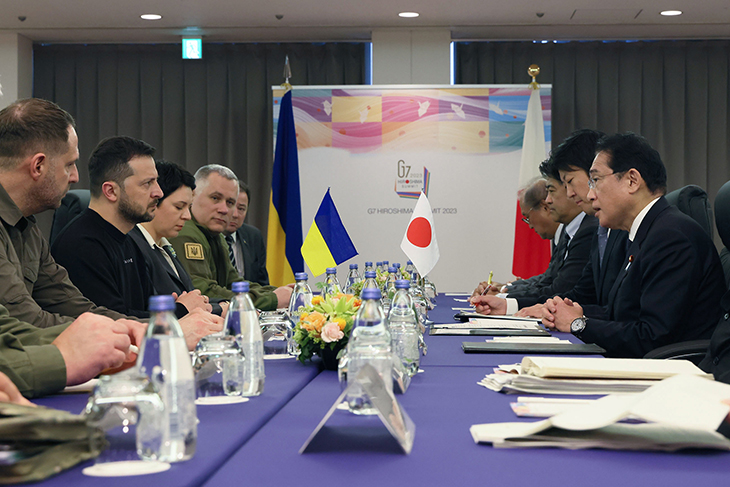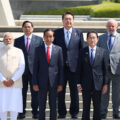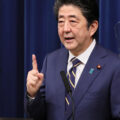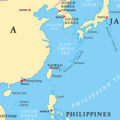The G7 Presidency Continues: Japan Should Show Leadership in “Reconstruction”

Ukraine’s expectations for Japan are based on Japan’s technological know-how and experience of reconstruction
Photo: Cabinet Public Affairs Office
President of Ukraine Volodymyr Zelenskyy, who visited Japan for the G7 Hiroshima Summit, associated “post-reconstruction” Ukraine with Hiroshima. As the holder of the G7 presidency and as a country providing reconstruction assistance in Ukraine, what does Japan need to do at this time?
Higashino Atsuko, Professor, University of Tsukuba
“I will never forget the attention you have paid to Ukraine and especially the support you have expressed for the sovereignty of Ukraine, its territorial integrity, and the Ukrainian people.”
President Volodymyr Zelenskyy, who attended the G7 Hiroshima Summit in Hiroshima in May this year, thanked Prime Minister Kishida Fumio with these words. The world’s eyes focused on this president of a country currently under invasion from Russia as he arrived in faraway Hiroshima.
Various reports from after the summit suggest that the Japanese government was initially hesitant to have President Zelenskyy participate in person. Yet, Japan also served as a link between Ukraine and the non-G7 “invited countries” such as India, South Korea and Indonesia that also participated in the summit. As a result, the G7 summit was able to demonstrate the “magnetic force” of the Japanese presidency, so it could be argued that all in all it was a success beyond expectations.
At the same time, there was some negative press about the G7 summit as well. The G7 Leaders’ Hiroshima Vision on Nuclear Disarmament, which stated that “threats by Russia of nuclear weapon use, let alone any use of nuclear weapons by Russia […] are inadmissible,” was criticized by saying that “issuing a document that permits the maintenance of the nuclear deterrence is ‘political use of Hiroshima.’” However, as long as Russia might try to change the status quo through the use of nuclear weapons, we will have no choice but to rely on nuclear deterrence. The circumstances and context surrounding nuclear weapons changed drastically after the start of the invasion in February 2022, when the Russian nuclear threat became apparent. We must first recognize that there is no contradiction whatsoever in making nuclear abolition the ultimate goal while doing our utmost to prevent Russia from using nuclear weapons.
There seem to have been some unachieved goals at the summit. As reported by the Financial Times on May 22, French President Emmanuel Macron and others were moving to issue a “joint declaration” of the G7 in support of the “Peace Formula,” which defines conditions for ending the war that Ukraine has laid out, but it seems that it never saw the light of day.
However, it appears that key points of the draft declaration made it into the “four views shared by the G7 countries” that Prime Minister Kishida presented at a presidency press conference (“respect for the principles of the UN Charter,” “peaceful resolution of conflicts through dialog,” “prevention of unilateral attempts to change the status quo by force,” and “adherence to a free and open international order based on the rule of law”). A future question will be how to concretely reconcile these “four views” with the Ukrainian “Peace Formula” as a way to expand this support to countries outside the G7.
Although the G7 has been mentioned much less in Japan since the end of the summit, we must not forget that Japan is tasked with leading the G7 as holder of the presidency until the end of 2023, which also includes realizing these post-summit matters. Especially this year, we are likely to see more situations that require immediate responses at the leader, ministerial, and administrative levels to emergent incidents arising in connection with the Russian invasion of Ukraine. A G7 foreign ministers’ meeting (telephone meeting) was promptly held during the rebellion by Evgeny Prigozhin, the founder of the Russian private military company Wagner, in June 2023. There was information sharing and cooperation among the G7. It has also been pointed out that Russia was preparing an attack on the Zaporizhzhya Nuclear Power Plant (ZNPP) as of the end of June. If this attack were to happen, not only Ukraine but also large areas of Europe could be devastated. Needless to say, in dealing with such contingencies, Japan needs to demonstrate leadership as the G7 presidency.
Moreover, in order to realize the various goals announced at the G7 summit, it is necessary to strengthen practical cooperation. One of the goals is through ongoing efforts to solve the “child deportation” issue that was included in the G7 Leaders’ Statement on Ukraine adopted at the summit. In order to recover Ukrainian children deported by Russia, it is essential that the international community, including the G7, continue to put pressure on Russia and cooperate with the investigations of the International Criminal Court (ICC). I think Japanese people ought to be more aware of how Japan as holder of the presidency is at the center of ongoing working-level consultations between Ukraine and the G7.
When first established, the G7 emphasized economic consultation and cooperation. Since then, the G7 has changed with the times and has started to engage with political and security aspects. As the G7 presidency, Japan is tasked with continuing to support Ukraine, condemning Russian aggression, and preparing for contingencies. Japan needs to lead the G7 as holder of the presidency and contribute to updating the G7’s role in response to changes in the international situation.
The vision of “post-reconstruction” that Zelenskyy saw in Hiroshima
“What the tragic pictures of Hiroshima show is what we are seeing in Ukraine today. Unfortunately, what is happening in Bakhmut is a tragedy, but I am convinced that we will be capable of the kind of reconstruction and rebuilding that made Hiroshima what it is today.”
That is what President Zelenskyy said at the post-summit press conference. It is said that he was deeply shocked when he saw the record of the devastation of Hiroshima at the Atomic Bomb Museum, but at the same time, he might have seen the future of Ukraine in Hiroshima, a city that has accomplished amazing reconstruction. Asked at the press conference what he expects in terms of support from Japan, he mentioned “energy, railways, modern technology, and healthcare.” This is realistic in light of Japan’s track record of support.
For example, Japan has provided state-of-the-art medical equipment to a Ukrainian military hospital in Donbass via UN agencies since 2014. After the summit, as requested by President Zelenskyy, Japan has expanded medical assistance to Ukraine. Wounded Ukrainian soldiers have been admitted to a Japanese Self-Defense Forces hospital to assist in their rehabilitation. Helping wounded soldiers should also prove to be an important form of reconstruction support.
Moreover, the mobile water purification equipment provided by Yokohama City to its sister city Odesa in 2022 has been put to use not for only Odesa but also neighboring Mykolayiv, ensuring drinking water for as many as 100,000 people in case of an emergency. Although the hurdles to arms provision are extremely high in Japan, there remains room for expanding such humanitarian contributions and assistance led by local governments.
President Zelenskyy’s reference to Japan’s excellent railway system also attracted attention, and it is consistent with previous claims made by Ukrainian intellectuals. For example, the distance between Tokyo and Hiroshima of about 830 km is about the same as between Kyiv and Simferopol in Crimea. Former Chair of the FA Committee of the Ukrainian Parliament Hanna Hopko and others have always argued that they should build a “railway of victory” between Kyiv and Crimea once Crimea is recaptured, wanting Japanese bullet trains to run there.
Furthermore, Oleksandr Kubrakov, Deputy Prime Minister for Restoration of Ukraine and Minister for Communities, Territories, and Infrastructure Development of Ukraine, who attended the G7 Transport Ministers’ Meeting in Ise-Shima, Mie Prefecture in mid-June, apparently conveyed to the Japanese side that he wants to rebuild the destroyed Ukrainian railways according to the Japanese bullet train standard, hoping for Japanese support to that end.
This means that the “broad gauge” (1,520 mm) that Ukraine had previously adopted will be replaced with the “standard gauge” (1,435 mm) used by EU members and Japanese bullet trains, which would dramatically increase connectivity between Ukraine and neighboring EU countries. If Japan were to participate in Ukraine’s railway reconstruction project, Japan would help build a railway line connecting Ukraine and Europe. Above all, it would serve as a symbol of reconstruction.
The high level of maintenance technology and operation that Japanese railways possess is already known in Ukraine, with many stakeholders hoping for the creation of a “sustainable rail system” according to the Japanese model. Ukraine’s very concrete expectations of Japan are something that Japanese railway officials should be aware of. Ukraine is not only looking for reconstruction funds and weapons from other countries. In particular, what they hope to get from Japan is technology and know-how as well the very experience of reconstruction that Japan has gained in numerous instances.
Don’t limit reconstruction support to the government level
Japan has signaled that it wishes to hold the “Japan-Ukraine Conference for the Promotion of Economic Reconstruction” in Japan at some point from the end of the year to the beginning of next year. Crucial in promoting Ukraine’s reconstruction is a concrete investment plan that actively involves private companies. However, with no end in sight to the Russian invasion, exceedingly few private companies seem willing to get involved with Ukrainian reconstruction and investment.
While concerns about the risks of investing in a country at war are understandable, Ukraine’s expectations for good infrastructure investment for Japan are very high and very specific. Moreover, many Ukrainians, including President Zelenskyy, associate Japan with the kind of reconstruction they want to achieve and hope for Japanese cooperation. The involvement of not only the Japanese government but also private companies and local governments in supporting Ukraine will send encouragement that goes far beyond mere financial support. Simultaneously, it will greatly enhance the status of Japan as a reconstruction-supporting country.
Translated from “G7 Gichokoku wa mada tsuzuku: Nihon wa ‘Fukko’ de shidoryoku shimese (The G7 Presidency Continues: Japan Should Show Leadership in “Reconstruction”),” Wedge, August 2023, pp. 8-10. (Courtesy of WEDGE Inc.) [September 2023]
Keywords
- Higashino Atsuko
- University of Tsukuba
- Volodymyr Zelenskyy
- Ukraine
- G7
- Hiroshima
- Japan
- G7 presidency
- Hiroshima Vision on Nuclear Disarmament
- nuclear threat
- Zaporizhzhya Nuclear Power Plant
- Peace Formula
- child deportation
- reconstruction assistance
- post-reconstruction Ukraine
- energy
- railways
- bullet train
- modern technology
- healthcare
- water purification
- Japan-Ukraine Conference for the Promotion of Economic
- Reconstruction





